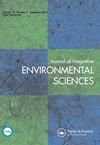Global mitigation potential and costs of reducing agricultural non-CO2 greenhouse gas emissions through 2030
IF 3.5
4区 环境科学与生态学
Q3 ENVIRONMENTAL SCIENCES
Journal of Integrative Environmental Sciences
Pub Date : 2015-12-18
DOI:10.1080/1943815X.2015.1110183
引用次数: 70
Abstract
Abstract Agricultural emissions account for 53% of 2010 global non-CO2 emissions and are projected to increase substantially over the next 20 years, especially in Asia, Latin America and Africa. While agriculture is a substantial source of emissions, it is also generally considered to be a potential source of cost-effective non-CO2 GHG abatement. Previous “bottom-up” analyses provided marginal abatement cost (MAC) curves for use in modeling these options within economy-wide and global mitigation analyses. In this paper, we utilize updated economic and biophysical data and models developed by the US Environmental Protection Agency (EPA) to investigate regional mitigation potential for major sources of agricultural GHG emissions. In addition, we explore mitigation potential available at costs at or below the estimated benefits of mitigation, as represented by the social cost of carbon. Key enhancements over previous regional assessments include incorporation of additional mitigation options, updated baseline emissions projections, greater spatial disaggregation, and development of MAC curves through 2030. For croplands and rice cultivation, biophysical, process-based models (DAYCENT and DNDC) are used to simulate yields and net GHG emissions under baseline and mitigation scenarios while the livestock sector is modeled by applying key mitigation options to baselines compiled by EPA. MAC curves are generated accounting for net GHG reductions, yield effects, livestock productivity effects, commodity prices, labor requirements, and capital costs where appropriate. MAC curves are developed at the regional level and reveal large potential for non-CO2 GHG mitigation at low carbon prices, especially in Asia.到2030年减少农业非二氧化碳温室气体排放的全球缓解潜力和成本
农业排放占2010年全球非二氧化碳排放的53%,预计未来20年将大幅增加,特别是在亚洲、拉丁美洲和非洲。虽然农业是一个重要的排放源,但它通常也被认为是具有成本效益的非二氧化碳温室气体减排的潜在来源。以前的"自下而上"分析提供了边际减排成本曲线,以便在全经济范围和全球减排分析中对这些备选方案进行建模。本文利用美国环境保护署(EPA)开发的最新经济和生物物理数据和模型,研究了主要农业温室气体排放源的区域减缓潜力。此外,我们还探讨了以碳的社会成本为代表的、等于或低于估计的缓解效益的成本所具有的缓解潜力。与以前的区域评估相比,主要的改进包括纳入了额外的缓解方案、更新的基线排放预测、更大的空间分类以及制定到2030年的MAC曲线。对于农田和水稻种植,使用基于生物物理过程的模型(DAYCENT和DNDC)来模拟基线和缓解情景下的产量和温室气体净排放量,而通过将关键缓解方案应用于EPA编制的基线来模拟畜牧业。MAC曲线的生成考虑了温室气体净减少量、产量影响、牲畜生产力影响、商品价格、劳动力需求和资本成本。MAC曲线是在区域一级发展起来的,显示出以低碳价格减缓非二氧化碳温室气体的巨大潜力,特别是在亚洲。
本文章由计算机程序翻译,如有差异,请以英文原文为准。
求助全文
约1分钟内获得全文
求助全文
来源期刊

Journal of Integrative Environmental Sciences
ENVIRONMENTAL SCIENCES-
CiteScore
3.90
自引率
0.00%
发文量
13
审稿时长
>12 weeks
期刊介绍:
Journal of Integrative Environmental Sciences (JIES) provides a stimulating, informative and critical forum for intellectual debate on significant environmental issues. It brings together perspectives from a wide range of disciplines and methodologies in both the social and natural sciences in an effort to develop integrative knowledge about the processes responsible for environmental change. The Journal is especially concerned with the relationships between science, society and policy and one of its key aims is to advance understanding of the theory and practice of sustainable development.
 求助内容:
求助内容: 应助结果提醒方式:
应助结果提醒方式:


